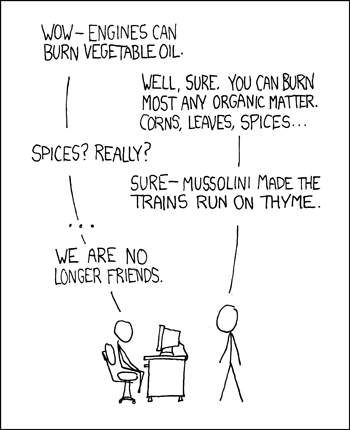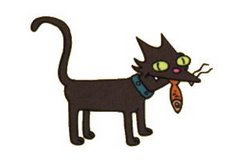Mind of Pi (#5)
Did you know that vehicles can run on spices? Yeah, Mussolini made the trains run on thyme! Ah ha ha ha! Weee! Happy Father's Day! 
p.s. comic from the delightful xkcd.
Did you know that vehicles can run on spices? Yeah, Mussolini made the trains run on thyme! Ah ha ha ha! Weee! Happy Father's Day! 
p.s. comic from the delightful xkcd.
Posted by
Cara
at
8:00 a.m.
1 comments
![]()
Well it's time to start dragging Wade to some sweet, sweet cultural moment worthy events! This weekend he saw his first opera, The Marriage of Figaro, at the Remai Arts Centre (aka. The Persephone Theater). A fantastic opera! Live orchestra, great singing and loved everyone's voices and interpretations of the music and roles. Plus lots of leg room! Good stuff! Even Wade liked it!
The Marriage of Figaro is a pretty nice intro to opera I think. It has a funny story, one or two songs that are recognizable from pop culture, and is one of the few operas where no one dies. Although Wade pointed out that that is how you know when an opera is over...when there are no more characters left. Ha!
Officially, "Le nozze di Figaro, ossia la folle giornata" (The Marriage of Figaro, or the Day of Madness), K. 492, is an opera buffa (comic opera) composed in 1786 in four acts by Wolfgang Amadeus Mozart, with Italian libretto by Lorenzo Da Ponte, based on a 1784 stage comedy by Pierre Beaumarchais ("La folle journée, ou le Mariage de Figaro"). The play itself ended up being banned because of it's satirical view of the aristocracy (a no-no in the pre-French Revolution days) but the opera is considered one of Mozart's most successful works (and that's saying something!).
The opera was written in Italian but takes place in Spain near Seville. Actually, the opera is part 2 in the adventures of Figaro as it continues on two years after the events in "The Barber of Seville" (actually there were three Beaumarchais plays about these same characters, the third being "The Guilty Mother"). The Barber of Seville was also turned into an opera by multiple people (not Mozart) although the most famous version wasn't done until 1816. That's the version used in "The Rabbit of Seville". Love that! But I digress...
The overture from The Marriage of Figaro is probably the most recognizable (often played separately as a concert piece), although the music isn't featured within the opera itself. You may remember the overture from the 1983 Dan Akroyd & Eddie Murphy movie "Trading Places", in which it forms the opening theme music over the intro scenes.
Lovers of the film The Shawshank Redemption may also remember the duetto (a short duet) piece between the Countess and Susanna from Act 3 called "Sull'aria...che soave zeffiretto". In it the Countess (singing first) dictates a fake love letter to her husband, the Count, in a zany plot to expose his intended infidelity with Susanna (the Countess's maid and Figaro's fiance). Not sure if that is "something so beautiful it can't be described in words". More amusing than beautiful and, in fact it is described in words...they're just Italian words.
Anyway, the story for Marriage of Figaro comes of as pretty convoluted (and it is) when you try to explain it but trust me it's easy to follow when you're there (if they have the subtitles that is). But, here goes: Figaro (the Count's valet) and Susanna (the Countess' maid) are engaged. The philandering Count has the hots for Susanna and "wants to get all up in that" (but the Count and Countess still love eachother and everything). The count has a page named Cerubino who keeps getting in trouble because he loves love too much and it incites the Count's enraged jealousy (repeatedly, it's a running gag). Also, Marcellina, an old chick that Figaro owes a significant sum of money, wants to marry Figaro and gets Dr.Bartolo (who hates Figaro from back in "The Barber of Seville") to help her with the legal matters. It seems Figaro can either pay her or marry her. But it turns out that Figaro is Marcellina and Bartolo's bastard love child so that doesn't pan out, which makes the Count mad because he's been trying to thwart Susanna's marriage to Figaro due to his aforementioned desire to tap that. Mayhem ensues, but eventually they trick the Count into thinking that he's meeting Susanna in the garden for a tryst, but really the Countess meets him there. And he's sorry for his alternating adulterous/jealous ways and will never do it again and everyone is happy. Yay!
On the whole I recommend it highly. Especially since it was good enough to get Wade to concede to seeing another opera!
p.s. To Wade: Yes you did!
p.p.p.s. Last summer my annual opera outing with Talina was La Traviata. But last year was a bit of a wash blog-wise as I was super busy with new job and romance and what-not. That in no way reflects on the quality of La Traviata, as it was delightful, but I've decided not to pretend I have a time machine and I'm going to start fresh with new stuff. But for the record, thumbs up on La Traviata! And I reserve the right to pretend I have a time machine in future if I ever come across the program and it reminds me.
p.p.s. I also dragged Wade to the ballet (Swan Lake) in Regina last winter. Which should also have been a cultural moment post (refer to p.s. above about starting fresh). It was pretty cool as Wade had never been to the ballet before, but it was unfortunate because the performance wasn't the best I've seen. Made worse by the lack of live music and the so-so supporting cast of dancers. But still enjoyable, I may just be becoming a snob.
Posted by
Cara
at
10:24 p.m.
0
comments
![]()
Labels: cartoons, cultural moment, music, watch this
 Well here we are making the figurative trek "out East" to check out what kind of words they got out there. We'll just see how well Ontario stacks up against BC's "fart", Saskatchewan's "dink" (heeheehee), and Manitoba's "hell". In the interest of me not really caring to figure it out, I've included all the edge overlap with Quebec and to South (as shown in the image to the right) and they can just fight amongst themselves as to who owns what (we'll cross that bridge when we get to it). Also, remember that I put the Manitoba overlap with Manitoba. Here are Ontario's 54 words (FYI: CJ, CH, DJ, EJ, FJ, GK, and GH had no words):
Well here we are making the figurative trek "out East" to check out what kind of words they got out there. We'll just see how well Ontario stacks up against BC's "fart", Saskatchewan's "dink" (heeheehee), and Manitoba's "hell". In the interest of me not really caring to figure it out, I've included all the edge overlap with Quebec and to South (as shown in the image to the right) and they can just fight amongst themselves as to who owns what (we'll cross that bridge when we get to it). Also, remember that I put the Manitoba overlap with Manitoba. Here are Ontario's 54 words (FYI: CJ, CH, DJ, EJ, FJ, GK, and GH had no words):
AH – agha, ache, aahs
AG – alga
BH – baht
BG – bigs, begs, bags
BF – biff, baff
CI – clip, chit, chis, chip, chin, chid, chic, chia, ceil, cain, caid
CG – cage
DI – djin, deil, dais
DH – dahs, dahl
DG – digs, dags, dago
EI – egis, edit
EH – elhi, echo, eche
EG – eggs, edge
FI – flit, flip, flic, fair, fain, fail
FH - fehs
GI – glim, glib, glia, gait, gain
HI – heir, heil, hair, hail, haik
Well, there's an ethnic slur, but that's not really a swear, just offensive, so no good (that one's actually in Quebec). Oh well, we can learn a few new word meanings anyway. For example "agha" is a title of honour in Turkey and other Muslim countries; a "baht" is a monetary unit in Thailand; "cain" is Scots/Irish English in origin and refers to rent paid in kind (instead of money that is, especially a percentage of a farm crop); a "caid" is a Muslim tribal chief (I'm pretty sure I've used that in Scrabble before); "deil" is Scots for a devil or mischievous person; "egis" is another way of spelling "aegis", which refers to protection, support or sponsorship, or being under the auspices of something; "elhi" is an adjective referring to being of or relating to elementary and high school.
Dang it Ontario! You've failed me! But, on the plus side an excerpt from my series of Borden System posts has ended up in the May issue (Vol 32) of the Saskatchewan Archaeological Society newsletter as the article "The Borden System Defined". The article was trimmed from this post. So much fame! I'll try not to let it go to my head.
p.s. This is my second blog-post related article in the SAS newsletter. The last one being from this post about making and excavation screen.
Posted by
Cara
at
7:19 p.m.
0
comments
![]()
Labels: archaeology, BSwords

